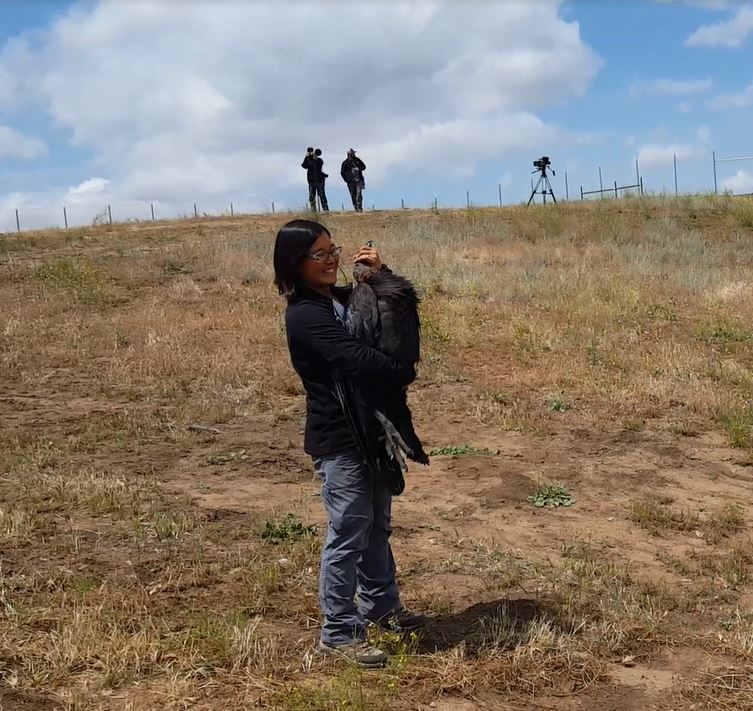By Linda Uyeda and Aaron Wirsing
| One of the great joys of running a research lab is getting to check in on former graduate students. Here, we catch up with alumna Linda Uyeda (’15), the first PEL student to earn a PhD. As a doctoral student, Linda explored the relationship between water monitor lizards (Varanus salvator) and humans in Indonesia. As you'll see below, she has now shifted her attention to one of North America's most iconic species. Linda is currently living in southern California and has been working with the U.S. Fish and Wildlife Service (USFWS) California Condor Recovery Program since 2015. She first began with the Recovery Program as a Great Basin Institute Research Associate/Monitoring Technician, and was later hired on as a Condor Biologist with the Santa Barbara Zoo, in partnership with USFWS. Earlier this year, Linda transitioned to a USFWS Wildlife Biologist position within the Recovery Program, based out of the Hopper Mountain National Wildlife Refuge Complex in Ventura, California. | Photo Credit: Nadya Seal Faith, Santa Barbara Zoo |
The California condor (Gymnogyps californianus) is listed federally as an endangered species. With a 9.5 foot wingspan, and weighing up to 25 pounds, it is the largest land bird in North America. California condors are carrion feeders, with common food sources including carcasses of large mammals such as deer and cattle. Challenges to the condors’ survival in the wild include habitat loss, complications resulting from the ingestion of microtrash, and electrocution from power poles, but lead poisoning from consumption of lead-contaminated carcasses remains as the greatest obstacle to overall population recovery.
The primary aim of the Recovery Program, a multi-organization collaborative effort led by the USFWS, is the recovery of the California condor to a self-sustaining, free-flying population. There are many partners involved in the California condor recovery effort, with some organizations focused on captive populations, and others tasked with management of the free flying population throughout the species’ range. The USFWS Hopper Mountain National Wildlife Refuge complex based in Ventura, California, is responsible for the management of the southern California population of California condors. Management activities include monitoring wild condor nests to assess chick development and to remove microtrash, tracking day-to-day condor activity, and conducting biannual health checks of the entire free-flying flock to monitor for lead exposure. Captive-bred individuals are also introduced to the free-flying population each year, and are monitored to ensure their successful integration into the flock.
Since 1982, when there were only 23 California condors worldwide, recovery efforts have increased the population to over 450 birds, including over 250 flying free in the wild! Of this total population, the free-flying southern California condor flock with which Linda works currently numbers ~80 individuals.
After spending multiple seasons tracking and handling water monitor lizards in the dense tropical forests of Indonesia, learning the proper handling and management of California condors has been a fun new challenge for Linda. These days, she spends a lot of time tracking and observing condors in the open grasslands, steep canyons, and rocky cliff areas that this species calls home. “It’s great to play even a small part in the recovery of the California condor, and to contribute to such a longstanding and successful recovery program.”
The primary aim of the Recovery Program, a multi-organization collaborative effort led by the USFWS, is the recovery of the California condor to a self-sustaining, free-flying population. There are many partners involved in the California condor recovery effort, with some organizations focused on captive populations, and others tasked with management of the free flying population throughout the species’ range. The USFWS Hopper Mountain National Wildlife Refuge complex based in Ventura, California, is responsible for the management of the southern California population of California condors. Management activities include monitoring wild condor nests to assess chick development and to remove microtrash, tracking day-to-day condor activity, and conducting biannual health checks of the entire free-flying flock to monitor for lead exposure. Captive-bred individuals are also introduced to the free-flying population each year, and are monitored to ensure their successful integration into the flock.
Since 1982, when there were only 23 California condors worldwide, recovery efforts have increased the population to over 450 birds, including over 250 flying free in the wild! Of this total population, the free-flying southern California condor flock with which Linda works currently numbers ~80 individuals.
After spending multiple seasons tracking and handling water monitor lizards in the dense tropical forests of Indonesia, learning the proper handling and management of California condors has been a fun new challenge for Linda. These days, she spends a lot of time tracking and observing condors in the open grasslands, steep canyons, and rocky cliff areas that this species calls home. “It’s great to play even a small part in the recovery of the California condor, and to contribute to such a longstanding and successful recovery program.”




 RSS Feed
RSS Feed